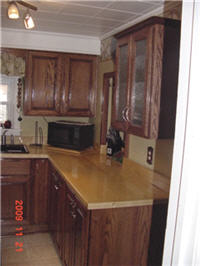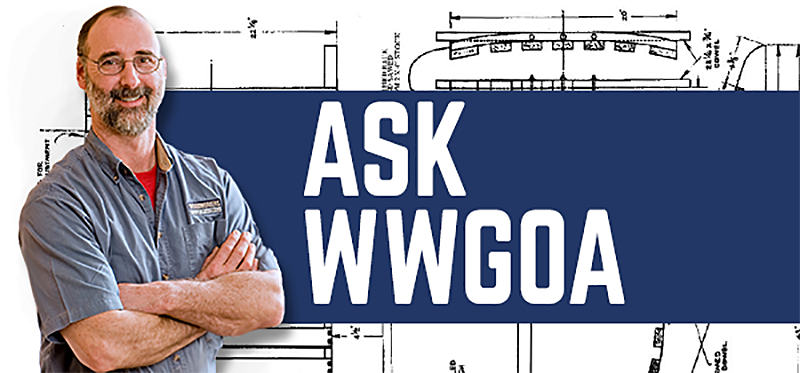 Question:
I built a kitchen for my nephew from the ground up and it didn't turn out too shabby--for a beginner. The top is white hard maple and the rest is red oak. (See attached photo.) These have been installed in his kitchen since June 09. A problem has developed on the cabinet side at the end of the long "L". The panel is solid oak, not the cabinet grade plywood. It has warped inward about 3/16". No other warping has occurred in any of the other cabinets. What could have caused this to happen? The panel was pieced together from two pieces and is 3/4" thick."
Question:
I built a kitchen for my nephew from the ground up and it didn't turn out too shabby--for a beginner. The top is white hard maple and the rest is red oak. (See attached photo.) These have been installed in his kitchen since June 09. A problem has developed on the cabinet side at the end of the long "L". The panel is solid oak, not the cabinet grade plywood. It has warped inward about 3/16". No other warping has occurred in any of the other cabinets. What could have caused this to happen? The panel was pieced together from two pieces and is 3/4" thick."
Submitted by ggleixner
That's a very impressive job. Nice work!
When you refer to an end panel, I don't know if you mean a base cabinet or upper. If you glued two boards together to make a 24" wide base cabinet end panel, the problem is that the boards you put together were too wide to use this way. It's best if the boards in your glue-up are 4"-6" wide, so two boards for a 12" wide upper would work.
A couple things can lead to a glued up panel warping. It's possible that the material wasn't dried correctly. This is often called case hardening, and leads to the outside surfaces being at a different moisture content than the core of the piece. If you planed the wood, did you remove the same amount from both faces? If a lot of planing is done and more material comes off one face than the other, the board can warp. Did the wood have plenty of time to acclimate to your shop before you used it? I'm in Wisconsin and in the winter, I make sure my material is in the shop 2-3 days before I plan on using it. If your shop is a separate building, are you controlling heat and humidity there? It's best if the conditions in which you build the project are the same as the conditions in which it'll live. For me, this meant adding a humidifier to my shop in the winter, because everyone up here humidifies their houses all winter long. And, of course, I've got heat in the shop. How about the location of that specific panel? Is it near a dishwasher or other steam source? Excessive ambient humidity could make a panel warp.
If all the material you used came from the same source, and you're not seeing warping anywhere else, you could simply have a couple of hinky boards. Plenty of woodworkers recommend alternating the direction of the annual rings to make certain movement of each board counteracts its neighbor. If I have followed all the guidelines above, I don't worry about alternating the ring pattern. However, on future glue ups, if you want a little extra stability insurance, take the extra step of alternating the rings.
George
Do you have a question for WWGOA? Ask us on Facebook or email editor@wwgoa.com. Note: questions may be edited for clarity and relevance.

A handy man put plywood veneer end panels on my kitchen cabinets. Unfortunately the glue is not holding and the ends are lifting. I can not remove the panels to re-glue. Nor can I figure out how to get glue where needed. What kind of glue to use that will not lift? Any suggestions?
I am making wood signs, those rustic framed ones where the frame is General Finishes and the boars is white painted birch or plywood. I’m generally using the birch because I don’t like the way the plywood absorbs paint unless sanded quite a lot. Recently I decided to use up the plywood, I sanded it smooth and use triple thick polyurethane which has made is usable. I have a piece that is slightly warped. I have not polyurethane’d it yet. I put heavy items on it and it seems a bit better but not perfect. The bend is not huge. My question is, will brad nailing and gluing a frame keep it straight or will it overpower the frame and warp anyway over time? Thanks!
I ihave a large wooden frame, anchored to my deck. It is 8 feet high and 10 feet long with a upright 2x4 in the centre. What addition 2x4s do I. Red to add to prevent the frame from warping? Thanks Tom
Hi. I am lucky enough to be moving into a new townhouse, and I am watching the build as it progresses. I noticed that some vertical boards in the structure of the closet are warped. Will they continue to warp more? Is this a problem that should be changed? Will it become a problem later? Thanks!
Hello, I have walnut circles fresh cut pieces that I want to make table tops out of. They are 30"-22"3" . How can I finish these so they don't warp? I hear soaking them in a solution that helps to stop cracking or splitting such as Peg a polyethylene glycol stabilizer. Is this a good idea.? I just had them planed and fine sanded. The circles were just cut 3 weeks ago. Thank you for any help. Brenda
I have left-over long leaf pine boards averaging 5 1/2 x 96 inches. We had these cut from lightning damaged trees on the farm. I have a lot of left-overs now that have been in my unairconditioned barn here in SE Alabama (hot, humid summers). I would like to make some shop cabinets using these boards. I now have a table saw, bandsaw, jointer, and planer, so I can do a lot to even up these boards. The shop cabinets have to remain in the barn, the same barn where the lumber is. My question is whether there are precautions to use to prevent warping and movement of the glue-up'ed boards if I make panels out of them?
We just recently had a arbor constructed and the 4in x 6in x 10 ft rafters are warping on the ends, is there anything we can do to stop it. Thank you
I was trying to reproduce a table for a client at a different height. I had my carpenter make the round table top 40" diameter, 1.5" thick poplar wood. It was flat when we picked it up from the carpenter and then the faux finisher finished the product and brought it to my office and I laid it on top of another table and could immediately tell that it was over 1/2" warped. Looked twisted. Faux finisher said that she did it in her studio which has central air. It sat standing up on its side for a while and then it sat flat on 2 paint buckets when she finished it. I don't know if any of that caused the issue or if it sat in an unairconditioned space for a long period that I was not told about. I am having to remake out of pocket and want to avoid the same thing happening again. Any suggestions?
a wet cloth was set on my dresser,I caught it quickly but can tell it started to do something to the surface. Can I use furniture oil on it to keep it from getting bad?
A few months back I made a chess board out of 1/2" plywood. Just the other day I took a look at it and it warped. I plan on making another one to replace it. If I seal it with say for example with Thompson deck sealer before painting it, will that prevent it from warping?